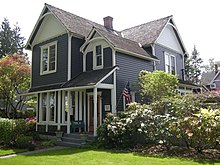John Frank Stevens
John Frank Stevens (born April 25, 1853 in West Gardiner , Maine , † June 2, 1943 in Southern Pines , North Carolina ) was an American engineer who built the Great Northern Railway in the United States and from 1906 to 1908 Was chief engineer in the construction of the Panama Canal .
Life
Stevens was born near West Gardiner in rural Maine to John Stevens, a tanner and farmer, and Harriet Leslie French. He attended Maine state school for two years. At the end of school in 1873 he could not find work under dire economic conditions and decided to go to the West. He came to civil engineering through his experience in a city planning office in Minneapolis . For two years he performed a variety of engineering jobs, including surveying and railway construction . He became a self-taught practical engineer, driven by the "single-minded tenacity of a bulldog," as he himself described it. In 1878 Stevens married Harriet T. O'Brien. They had five children, two of whom died in childhood.
In 1886, at the age of 33, Stevens became chief operator on the South Shore and Atlantic Railway in Duluth, Minnesota , in charge of running the line from Duluth to Sault Ste. Marie (Michigan) across the Michigan Upper Peninsula . Although a large part of his job was surveying, he was involved in all phases of railroad construction: exploration, drafting, planning, and construction.
In 1889 James J. Hill hired him as a design engineer on the Great Northern Railway . He was the first white American to discover the Marias Pass in the Continental Divide and the "Stevens Pass" in the Cascade Range was named after him. Hill promoted him to chief engineer in 1895 and later to general manager. During that time on the Great Northern, Stevens built over 1,000 miles of railroad including the first Cascade Tunnel.
Panama Canal
Stevens left the Great Northern in 1903 and went to the Chicago, Rock Island and Pacific Railroad in Chicago , where he became vice president. In 1905, Theodore Roosevelt hired him on Hill's recommendation as chief engineer for the construction of the Panama Canal .
Stevens' main success in Panama was building the necessary infrastructure for the canal. He renewed the Panama Railway and designed a system to dispose of the excavated soil on the rail and dump it. He also built suitable housing for the sewer workers and monitored sanitation programs and measures to eradicate yellow fever and other diseases on the isthmus. Stevens was against a canal at sea level like the one the French wanted to build. He convinced Roosevelt to build a higher canal with dams and locks.
retreat
Stevens suddenly withdrew from the canal construction project in 1907, much to Roosevelt's annoyance when work turned to building the canal itself. As a railroad engineer, Stevens had little experience building locks and dams and probably realized that he was no longer the best person for the job. Stevens may also have seen with hindsight that the Cascade Tunnel for which he was responsible had been built too steep. The real reasons for his withdrawal have never been revealed.
After the collapse of the Russian Empire in 1917, the Provisional Russian Government asked President Wilson for help in setting up the transportation system. Stevens was sent to Russia to chair a commission of railway experts to organize the system, including the Trans-Siberian Railway . After the October Revolution , work was stopped. Stevens remained in Allied Manchuria and chaired a committee dealing with the administration and operation of the Chinese Eastern and Siberian Railways. He stayed there until 1923 when the occupying forces withdrew. After returning to the United States, he worked as a consulting engineer. In 1928, Stevens was elected to the American Academy of Arts and Sciences . He ended his career in Baltimore in the early 1930s. He retired to Southern Pines, North Carolina, and died there at the age of 90.
Individual evidence
- ↑ http://www.pbs.org/wgbh/amex/streamliners/peopleevents/p_stevens.html People & Events: John Stevens, 1853-1943
swell
- "Conquering the Landscape (Gary Sherman explores the life of the great North American pioneer John Frank Stevens), HISTORY MAGAZINE, July 2008
- "Stevens, John Frank" in American National Biography . American Council of Learned Societies, 2000
| personal data | |
|---|---|
| SURNAME | Stevens, John Frank |
| BRIEF DESCRIPTION | American railroad engineer and chief engineer in the construction of the Panama Canal |
| DATE OF BIRTH | April 25, 1853 |
| PLACE OF BIRTH | West Gardiner , Maine |
| DATE OF DEATH | June 2, 1943 |
| Place of death | Southern Pines , North Carolina |
